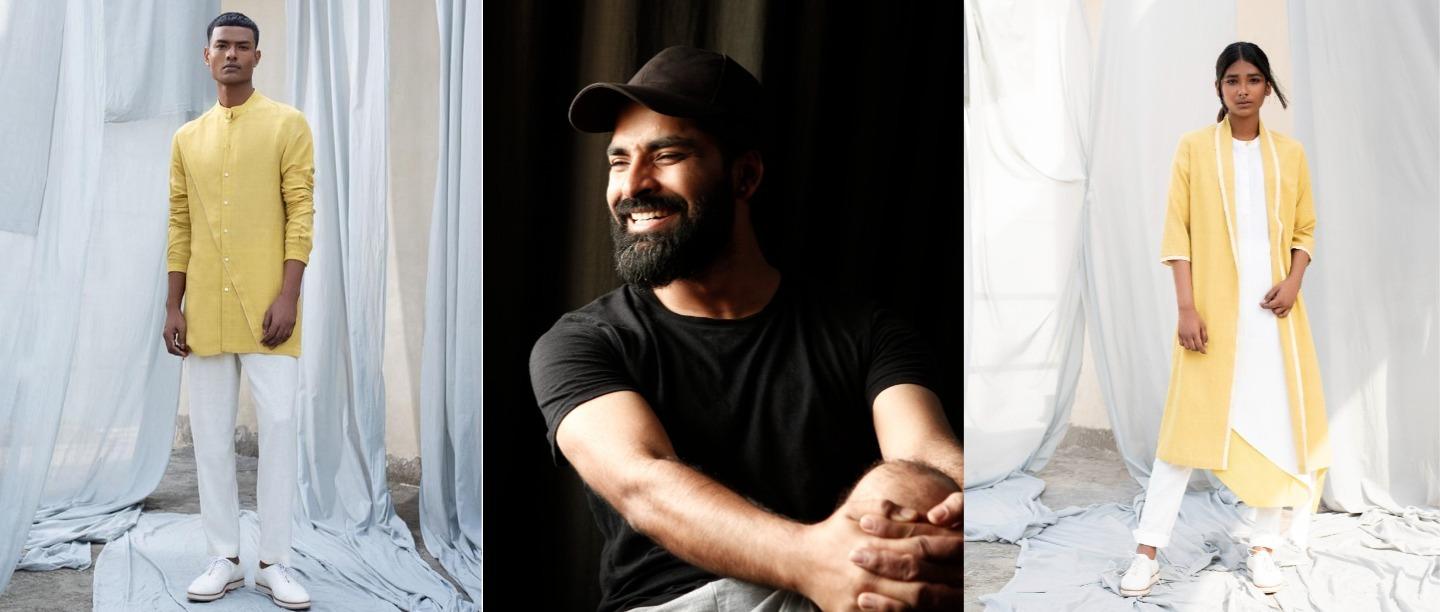Fashion design generally adheres to a basic chronology–you envision a garment and then look for suitable textiles and ways of moulding them into your vision. Ujjawal Dubey of Antar Agni takes a slightly different approach. For him, it is the fabric that reigns supreme as the central aesthetic of all his creations. He refuses to put the textile in a box. The results? Sartorial marvels that have won him international acclaim for their post-new age X naturalist aesthetics.
For Ujjawal, the fabric is not just a part of the process. It is something way bigger, something that has a character of its own. Each fabric has a story that needs to be told and deserves to be treated with a certain reverence. The designer here is just the medium whose work is to enable the natural, handwoven Indian fabrics to tell their own story. And this is not just theory. Pick up any of Antar Agni’s designs and their 3-D details, and unique silhouettes will testify to the same. In a recent interaction with POPxo, Ujjawal talked about his fascination with handwoven fabrics and his respect for their natural form.
Respecting The Textile

Antar Agni garments are like sartorial origami. Ujjawal carefully picks up natural and handmade fabrics to play with and create statement urban wear. His design approach involves making the fabric the hero. “Handmade fabrics have a natural aesthetic and while the process is applied to it, it elevates the entire look and feel of the garment. The textures and fluid silhouettes are achieved through the use of these fabrics which help us in creating the final look,” says Ujjawal.
His fascination with fabrics and architecture is apparent in the designs. Sonam Kapoor was recently seen in the Stroke Shirt by the designer that featured a 3D wing (all created by manipulating a fabric) as its central detail. But that’s not even the most interesting part of his design language. Most of what Ujjawal creates is men’s clothing and yet thirty percent of his customers who buy these separates are women. In fact, even Sonam’s Ecru shirt is featured on a male model on the brand’s website. It is the androgynous appeal of the garments that make them all the more exquisite, modern, and futuristic.
Reinventing Handloom

Ujjawal is reinventing handloom in the sense that most of it actually involves reworking the design and not the textiles. He has a genuine fascination with handloom fabrics and the way they help in manipulating the outcome. “We have reinvented Indian handloom by creating tailored jackets which are made out of hand-spun and handwoven fabrics. We usually work with handwoven cotton and silk. I have been working on fabrics like linen, zari, and lycra blends. Once we start playing with the fabrics they themselves mould into silhouettes,” adds the designer.
Learning From The Artisans

Just like his design ideology, Ujjawal’s relationship with the artisans is also more of a give-and-take. While Antar Agni has helped them upgrade their skills, the designer has ensured to learn from them as well. “Over the years, we have been working with our weavers constantly and helped them upgrade their skills, and in turn also learned a lot from their design techniques,” he says.
For the majority of his creations, Ujjawal uses the Malkha fabric which is sourced from Andhra Pradesh and has collaborated with many master weavers from Bhagalpur and Meerut. “We get almost 70 per cent of our fabrics made from craft clusters like Maheshwar, Meerut, Bhagalpur, and Andhra Pradesh,” he adds.
Handloom Is Not Charity

Handloom is something precious, something divine and that is why Ujjawal says that we need to save it not as an act of charity to the artisans but because it is just that important to us. “Designers, as people who work with these crafts, should try and work with the artisans to update the techniques as well the aesthetics. It is important to not use handloom as charity but work on it to make it into a flourishing industry that is commercially beneficial to all, only then will it be able to survive, the charity won’t last long,” he concludes.
To celebrate the ethereal beauty and the undeniable allure of Indian handicrafts, we are observing a handloom week this August through a series, titled Seven Days of Handloom. The series aims to introduce designers and brands who are working to preserve and reinvent the Indian handlooms. Click here to read about Handloom Rugs, Chanderi, Maharashtrian Handloom, Kanchipuram, Banarasi, and Linen.
Featured Image Courtesy: Ujjawal Dubey



